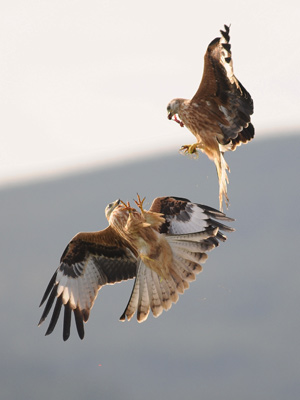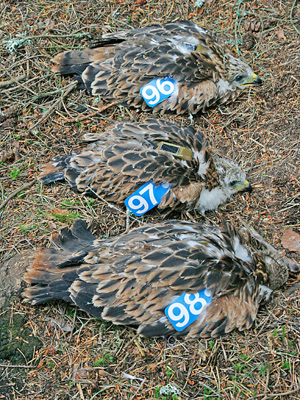
Scottish Raptor Study Group
Monitoring and conserving Scotland's birds of prey
Red Kite

The red kite became extinct as a Scottish breeding bird species in the late nineteenth century, primarily due to human persecution by sporting estates, the taxidermy trade and egg collecting. The red kite was formerly an abundant and widely distributed species in the country prior to this time. Most of the last documented breeding attempts in Scotland were in the Highlands in the 1870-1880s and there is one later record of a pair nesting in Glen Garry (Lochaber) in 1917 (Baxter and Rintoul). Clues to their former presence live on in old place names, particularly with the old Scots name for the red kite (the Gled), in names such as Gladhouse (Lothian), Gledfield (Highland) and Gledsmuir (Borders).
Between 1989 and 2009 a joint RSPB Scotland and Scottish Natural Heritage project was undertaken to reintroduce red kites to Scotland, with the ambition of restoring the bird eventually to all of its former range in the country. Between 1989 and 1994, 93 red kites of Swedish origin were reintroduced on the Black Isle (Ross-shire). This initial reintroduction was followed by a second reintroduction programme in central Scotland (Doune, near Stirling) between 1996 and 2001, releasing 103 birds of eastern German origin. In order to re-establish red kites in the south of Scotland, between 2001 and 2005 104 birds were released near Laurieston (Dumfries and Galloway), using donor stock from north Scotland and the Chilterns reintroduction project in England. Finally, between 2007 and 2009 101 red kites were released on the outskirts of Aberdeen with donor stock from the Chilterns and from central Scotland. The reintroduced birds have been closely monitored by RSPB Scotland staff using radio and wing tagging techniques. As populations of red kites have become larger SRSG members have also become increasingly involved in the annual monitoring effort.
In 2012 there were 214 breeding pairs of red kites in Scotland and 318 young were fledged. This is thought to be close to an accurate population estimate, although a few breeding pairs may be missed each year. The number of breeding pairs of red kites in Scotland has doubled every 4-6 years. The long term mean productivity of the Scottish red kite population is 1.8 young per pair laying eggs, which is at the top end of the European range for this species. Increasingly, and as planned, the range of red kites in Scotland is increasing, notably in Perthshire and Dumfries and Galloway. From wing tagging data we know that there is good interchange, and some interbreeding of birds, between the various established release and now wild breeding populations. It is expected that in the next few years, for example, that the populations of central Scotland and Aberdeen will join up in the Angus area.

The greatest threat to the Scottish red kite reintroduction remains illegal persecution (notably illegal poisoning), despite the fact that red kites pose little or no threats to any land use interests. Red kites are primarily scavengers in Scotland, although they will also take some live prey including voles, other small mammals and birds. The Black Isle population of red kites has suffered in particular from illegal persecution. In 2012 there were only 52 pairs laying eggs in the Black Isle area, whereas by comparison the Chilterns population in the south of England (which involved release of the same initial number of birds, and the established populations have similar productivity), now stands at between 900 and 1000 breeding pairs. During the period 1999-2006, an estimated 166 red kites from the Black Isle population were illegally poisoned and differential rates of illegal poisoning are confirmed to explain the difference between growth rates of the two red kite populations (Smart et al. 2010).
In Scotland, most adult breeding red kites are sedentary, although they will make short distance movements in response to poor weather. On average about a quarter of the juvenile red kites from the north and central Scotland red kite populations disperse, largely in a south westerly direction, in their first winter. Scottish birds have been located in Ireland, England and on several occasions in Iberia. The winter roosts of red kites are monitored annually, and a number of sites hold around 100 birds.
The red kite has also become a popular tourist attraction, of value to local economies, with several public viewing sites now established by private landowners at Argaty, near Doune; Tollie, near Dingwall; Bellymack near Laurieston; and Easter Anguston, near Aberdeen. At these sites, it is possible to see good numbers of red kites coming to small amounts of food provisioned for the birds.
Duncan Orr-Ewing
References:
Carter, I, (2001). The Red Kite. Arlequin Press, Chelmsford, Essex.
Evans I.M., R.H. Dennis, D.C. Orr-Ewing, N Kjellen, P-O Andersson, M Sylven, A Senosiain & F.C. Carbo. (1997). The re-establishment of the Red Kite breeding populations in Scotland and England. British Birds 90: 123-138.
Evans I.M., R.W. Summers, L. O'Toole, D.C. Orr-Ewing, R. Evans, N. Snell & J. Smith. (1999). Evaluating the success of translocating Red Kites Milvus milvus into the UK. Bird Study 46: 129-144.
Smart, J., Amar, A., Sim, I.M.W., Etheridge, B., Cameron, D., Christie, G and Wilson, J.D. (2010). Illegal killing slows population recovery of a reintroduced raptor of high conservation concern - The red kite Milvus milvus. Biological Conservation 143: 1278-1286.
Scottish Raptors•
Honey-Buzzard•
Red Kite•
White-Tailed Eagle•
Marsh Harrier
Hen Harrier•
Goshawk•
Sparrowhawk•
Common Buzzard•
Golden Eagle
Osprey•
Kestrel•
Merlin•
Hobby•
Peregrine Falcon•
Barn Owl
Tawny Owl•
Long-eared Owl•
Short-eared Owl•
Raven